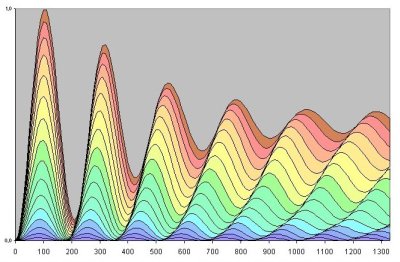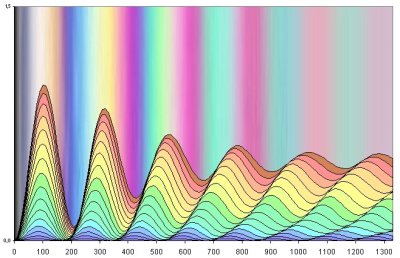
now with movie
A very simple way to create an object with known dimensions in the nanometer range (or at least one) is to make a soap bubble. The advantage here is that the thickness of the thin film of water can be measured directly with the naked eye.
 |
Making a thin film of water
Basically it is water and soap of which the sheet is made. Taking destilled water makes the film more elastic and adding sugar makes it more tough.
To make it observable the film should be stretched out in a frame. The frame can be made out of pipe cleaners but even a simple plasic frame will do. Lifting the frame horizontally from a bowl leaves the film of water in the frame.
When it is placed close to a horizontal position the water will slowly run downwards. The film becomes thinner over tens of seconds showing stripes of rainbow colours in the reflected light.
Analysis of the thickness
The reflected light on the water film is composed of two parts, the reflection from the top and from the bottom. The light will be at a maximum when the two components are in phase.
The light from the top of the film comes from the air and is reflected at the medium with higher density so it makes a phase jump of 180°. The light that is reflected at the bottom of the film makes no phase jump, so it just has to travel for a quarter of a wavelength through the layer forth and another quarter of the wavelentgh back to reach the same phase.
Measured at the yellow light with 580nm, a quarter of a wavelength is 145nm and in water ist is just 110nm. This thickness is easy to recognise in fig1. It is the first maximum where the maxima for all colours are close together and the appearance of the line is almost white. It is in fact yellow, as some blue and red parts are slightly shifted out but not that much that all colours appear as a rainbow.
Further on at a thickness of about 200nm all colours are interfering and a very characteristic dark or non reflective line appears. At the next maximum the colours show more dispersion and they can be observed separately. The next minimum is not so low and more rainbows follow. The ends of the visible spectrum start to overlap from the third maximum but with little intensity so that still a change of colours can be observed.
With movement in the air the lines of constant thickness flow and bend, without wind (and some sugar) almost the whole area except close to the lower part of the frame will be measured to be of a thickness below 50nm.
Fig 2 gives gives an impression of the appearance of the colour stripes on the film.
 |